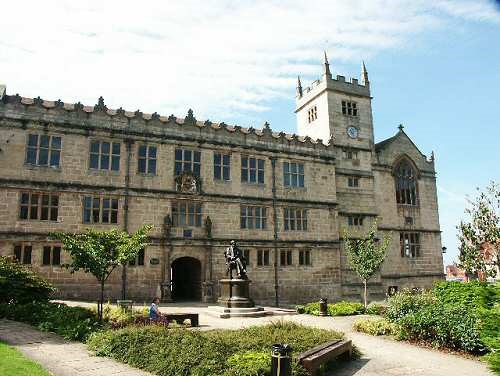

The majority of Shrewsbury's finest buildings were built using Grinshill stone. Grinshill is a small village which lies approximately 8 miles north of Shrewsbury. The co-ordinates take you to where you can see walls and buildings which have been constructed from two different colours of Grinshill stone.
Many areas of Britain are characterised by their building stones, such as the yellow coloured Jurassic limestone seen in the Cotswolds or the grey granite seen in Scotland. Shropshire contains rocks of 10 out of the 12 recognised major periods of geological time, with a greater concentration of variety than any equivalent area in the world. This has meant that across the county, one sees extensive use of local stone, and a range of buildings of very different apprearance.

Probably the best known stones are the sandstones quarried at Grinshill, which have gained a national reputation. This fine to medium-grained, massive sandstone, strongly cemented with quartz and virtually iron-free, was recognised from medieval times onwards as the preferred material for high-status buildings. Large column sections could be carved from its thick beds for architecture such as Attingham Hall or the Lord Hill monument in Shrewsbury. Earlier it had been brought into the county town for Shrewsbury School, now the library, Shrewsbury train station and the Market Hall. The quality of Grinshill stone is very high and it is a well-respected building material; so well-respected in fact that it was used at Chequers, the Prime Minister's country home, and for the lintels and door surrounds of 10 Downing Street.
What is interesting about Grinshill stone is its durability as a building material and its variation in colour, from the white which was used for the railway station, to the cream used for the library, and through to the red used for the castle. The colour variation in the sandstone is produced by an original film of hematite (iron oxide) which was deposited around each grain under arid conditions. This is preserved in the red sandstones but has been removed, probably by the fluids driven by igneous intrusion, to produce the white sandstone.
The composition of Grinshill Sandstone is dominated by quartz (c.70%), with minor components of feldspar (c. 10%), rock fragments (c. 9%) and clay minerals. These grains are cemented together by a secondary growth of quartz and feldspar. Importantly, the cement does not contain any calcium carbonate as this provides a ‘weak link’ in the rock when dissolved by acid rainwater, resulting in deterioration of the stone. The overprint of quartz and feldspar is less in the red sandstone and consequently this is not such a durable stone.
Your tasks
To log this cache, you will need to complete the tasks below. You can use information from the cache page and your observations at GZ to do this. Please message us with the info (rather than post it on your log). You can log a find once we have been sent a message. We may delete your log if your answer is way off the mark.
- Look at the walls on either side of the road. Both are built from Grinshill stone; one from the 'white' (on the library side) and one from the 'red' (on the castle side). How do they differ from each other? (Please take care crossing over the road here.)
- Can you see any evidence of erosion to the stone in either wall? If so, describe it.
- Look closely at the grains in the RED wall. Describe what you see.
- Why do you think that the 'white' Grinsill stone may have been chosen for 10 Downing Street, rather that the 'red'?
- As an optional extra, post a picture on your log of yourself and / or your GPSr by either of the Grinshill stone walls.